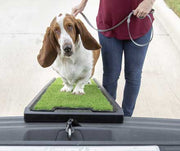How To Potty Train Your Puppy Like a Pro

"How long can they hold it?" is one of the most common questions when it comes to potty training your puppy. Potty training can be extremely difficult, especially if it is your first time being the sole caretaker of a puppy. There are three simple things to remember when potty training a puppy for the first time: plenty of walks, knowing their limits, and the power of a treat.
UNVEILING THE SECRET
It can be hard to get your puppy on a potty schedule when you don't have the correct information and knowledge needed to potty train efficiently. The good news is that there is a general rule you can follow to know how long your pup can hold it. Puppies can typically hold their urine or feces for one hour for every month old that they are. Remember, this schedule kicks in the minute you bring your puppy home.
SCHEDULING
Scheduling is one of the most important things when it comes to potty training. According to the general rule listed above, if your dog is 7 months old, then he can hold it for up to 7 hours. That means you cannot expect your pup to hold it past the 7 hours. Make sure that you walk him through the night once every 7 hours. This has been proven to work for most dog parents that stay true to a schedule. Waking up through the night can be tiring at first. But eventually, the task will get easier and your furbaby's bladder will adjust and grow.
WALKING THROUGH THE NIGHT
Unfortunately, the price to have a cute puppy often means waking up multiple times in the night to take your puppy potty. If a dog is forced to hold its urine for more than its allotted time, it can contract a Urinary Tract Infection (UTI). This is the last thing you want when potty training. UTIs can lead to more accidents and plenty of pain for your puppy. Making sure that your new furry family member goes out at the appropriate time will keep potential UTIs away and make potty training a breeze. If you live in an apartment complex or somewhere without a yard, puppy pads are often a good option for potty breaks in the middle of the night.
THE POWER OF THE TREAT
Once you've figured out how many hours your puppy can hold it, you are set to start training! This means you will always want to have treats or kibble on you, even when walking your pup. Every time the cycle ends and it is time to take your puppy on a walk, make sure you have treats tucked away somewhere on you. These little treat totes are perfect for holding a small amount of treats on you while keeping them tucked away from your dog as she does her business. That way your puppy isn't distracted by the treat, and he can sniff for his designated spot. Be sure to have patience the first few times and make sure to add in prompts.
PROMPTING YOUR PUPPY
Prompts are just as important as treats. Once you get your puppy outside on a leash and sniffing the ground, make sure to give him a prompt like "Go potty!" or "Make! fluffy, make!" Once your dog goes potty make sure to give him a treat and plenty of praise. This was a monumental moment for both you and your puppy, to celebrate! Make sure you continue your walk and don't return home immediately. That way – in your puppy's mind – walks are fun, long, and yield lots of treats and pets.
KENNEL TRAINING
Kennel training is another key step in fully potty training your puppy. Before you go anywhere in the morning, make sure to take your puppy on a quick walk. This will reset your puppy's clock and allow for more time in the day for him to hold it comfortably. When you get back from your errand and proceed to let your puppy out of his kennel, make sure to immediately put his leash on and go on another walk. This may seem excessive at first, but in his mind, he associates the kennel with walks and should not have accidents if you stick to the process.
KENNEL SIZE
Another key detail in the potty training process is the kennel size. Make sure the kennel is only big enough for your dog to stand up and turn around comfortably. Anything too big and your dog will see that space as disposable. If your dog makes that connection, he will use the extra space as his little backyard and will freely relieve himself whenever he pleases. This is not the ideal scenario. If the kennel you have is too big, hold onto it until your puppy grows, and purchase a smaller one for now.
Petmate offers a variety of kennels and crates for dogs in all stages of life. Having the right one that best fits your puppy's needs will make the potty training process easier for both you and your puppy.
Sources:
- https://www.akc.org/expert-advice/training/how-to-potty-train-a-puppy/
- https://pottybuddy.co/blogs/potty-buddy-blog/how-long-can-dogs-hold-their-pee
Previous article

Next article

Related posts
View all-

What Can You Use Instead of Cat Litter?
Traditional cat litter is convenient, but it’s not the only option. Many cat owners look for alternatives to reduce waste, save money, or avoid chemicals found in clay-based kitty litter. Some options offer better odor control, while others are more eco-friendly or gentler on a cat’s paws.
Read Article -

How to Keep My Backyard Smelling Fresh
A clean backyard should smell fresh, unlike pet waste, smoke, or mold. Bad smells can linger, especially when dog poop, urine, or food scraps attract flies and bacteria. If your yard has a foul odor, it's time to take action. The first step is cleaning up pet feces, trash, or rotting food. A garden hose can wash away dirt and urine from artificial turf, patios, and decks. To neutralize odor, Use baking soda, white vinegar, and essential oils.
Read Article -

What Supplies Do First-Time Cat Owners Need?
Bringing home a new cat is exciting, but making them feel safe and comfortable takes more than love. First-time cat owners must prepare with the right supplies to ensure a smooth transition. From a litter box to cat food and a warm bed, having the basics ready can help your new kitty settle in faster. This guide covers everything a new cat owner needs to make their new pet feel at home.
Read Article



